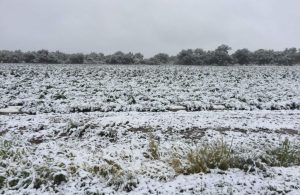
Heavy snow on Sept. 9, 2020, blankets the Functional Remedies hemp farm outside Pueblo, Colorado. (Photo courtesy of Tim Gordon)
(This is the 15th installment in a series focused on cultivation planning for marijuana and hemp growers. The previous installment is available here.)
Early snowstorms and freezes in September and October have plagued Colorado outdoor cannabis growers the past two years, damaging plants and leading to millions of dollars in losses.
And while the weather seems to be cooperating with no cold snaps so far this year, that situation could change at the drop of a hat.

“We’re hoping that the last two years were a fluke and not a new norm,” said James Lowe, co-owner of PotCo, an outdoor marijuana farm outside Pueblo, Colorado.
In October 2019, for example, Pueblo-based Los Sueños Farms – the state’s largest cannabis grower – estimated it lost about $7 million in an early freeze.
The early storms the past two years were bad enough that Colorado lawmakers passed a law this summer to help growers who need a contingency plan in the event of adverse weather conditions.
The unseasonable cold spells are another example of how climate change has led to more extreme, unpredictable weather for cannabis companies across the country.
Here are some tips and advice from southern Colorado growers on how to prepare for unseasonable snow and frost:
Reinforced trellis
Last September, PotCo was on track for a record harvest until heavy snow toppled the entire canopy, knocking over plants that were 6-7 feet tall.
Lowe initially estimated the early snowstorm cost his farm millions of dollars in damages.
“The next morning we were devastated. You couldn’t see the plants,” he said.
Fortunately for the company, the snow melted quickly and some of the cannabis recovered. PotCo ended up with a 10%-15% loss.
But others weren’t so lucky.
“Some farms were not able to recover from that,” Lowe said.
This year, PotCo worked to build a trellis that was robust enough to hold up in heavy snow.
“We’ve learned from failure,” Lowe said.
His team upgraded everything across the board, including using heavy-duty stainless steel wire to attach to the T-posts that hold up the canopy. Employees also reinforced the T-posts to support the trellis.
Last year, off-the-shelf nylon zip ties served as support for the plants.
“When you’re holding up hundreds of pounds of frozen plants, you have to do the math. How strong is a nylon zip tie?” Lowe asked.
Of course, it helps to have healthy cannabis with a strong root system.
Lowe also pointed out that, because his company is growing for the flower market, his plants can’t lie on the ground for any matter of time. A grower targeting the extraction market might not have to be as picky.
Tim Gordon, chief of staff at Impello Biosciences, an agriculture biotech science company based in Fort Collins, Colorado, also said he’s seeing marijuana and hemp farmers adding more trellis infrastructure.
Both THC and CBD cultivators are looking at the Farmers’ Almanac and expecting early winters, so they’re setting up simple infrastructure similar to what might be seen at a grape vineyard, according to Gordon.
“If you have a trellised system instead of those branches breaking, they have the support to withstand a heavy snow,” he added.
Fabric solution
Crop insurance would be a great solution, said Nick Drury, senior vice president of cultivation for vertically integrated Colorado cannabis company Lightshade.
But since that’s not an option for most marijuana producers – given that MJ remains illegal under federal law – Drury recommends using a row-cover fabric to spread across the crop. A couple of well-known row-cover brands are Reemay and Agribon.
Growers can drape the fabric over the crop to hold off snow and frost and help to keep plant temperatures up.
According to Drury, it’s one of the cheapest options out there. Some growers in areas that can get hail use the row-cover fabric, which also can double as insect protection.
He recommends using the fabric with a framework of bent conduit to create an arch similar to that of a greenhouse.
“I would not start an outdoor farm without having some type of infrastructure for cloth,” Drury said. “That’s very low-cost crop insurance that provides tons and tons of benefits.”
One tip: Don’t let the cloth touch the plants. If it snows and the cloth presses down on the plants, the cloth loses the air buffer that helps prevent the plants from getting too cold.
A couple of other options Drury suggests:
- Growers using pots could space butane-powered burners throughout the farm to slightly increase temperatures. It’s similar to what’s used in the fruit-tree industry.
- Large fans that keep the air moving can keep cold air from settling near the ground. This practice is used by vineyards on Colorado’s Western Slope.
- Irrigating before a frost can cause an exothermic reaction that releases heat. This is Drury’s least favorite method because, in late-stage cannabis, you want to avoid excessive moisture that can cause botrytis.
If the forecast sneaks up on you and you don’t have time to build any infrastructure, Drury suggests giving the plants a serious manicure.
“Cut all the tops off, harvest all those early,” he said. “Hang-dry them and leave the rest of the plant. Hedge your bet.”
Automation answer
Vertically integrated cannabis business The Green Solution has an outdoor facility in southern Colorado with more than 40,000 plants, according to the company.
Kevin McDermott, The Green Solution’s director of cultivation, said investing in automated harvest equipment has helped the company prepare for an unexpected weather event.
Although The Green Solution’s increased trimming capacity will aid in processing material, the company would still need to cut down, store and hang 40,000 plants.
“It will help us process quicker, but in extreme cases, we will have to pivot,” McDermott said.
That’s why the new statewide regulations are so important. McDermott said The Green Solution worked with the state’s Marijuana Enforcement Division to make those regulatory adjustments.
And while an extremely wet spring did slow the planting season, McDermott is excited about this upcoming harvest and predicts it will exceed last year’s yields.
Bart Schaneman can be reached at [email protected].

